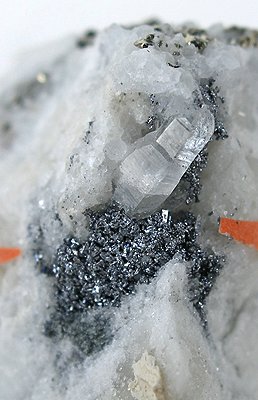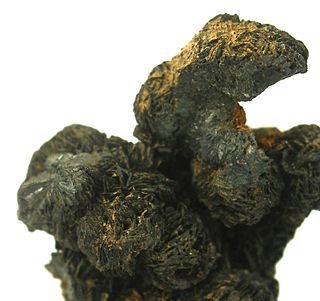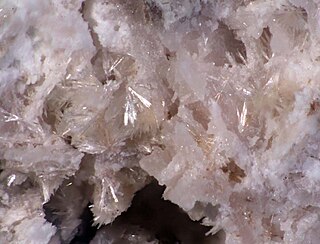
Optics is the branch of physics that studies the behaviour and properties of light, including its interactions with matter and the construction of instruments that use or detect it. Optics usually describes the behaviour of visible, ultraviolet, and infrared light. Because light is an electromagnetic wave, other forms of electromagnetic radiation such as X-rays, microwaves, and radio waves exhibit similar properties.

A waveplate or retarder is an optical device that alters the polarization state of a light wave travelling through it. Two common types of waveplates are the half-wave plate, which shifts the polarization direction of linearly polarized light, and the quarter-wave plate, which converts linearly polarized light into circularly polarized light and vice versa. A quarter-wave plate can be used to produce elliptical polarization as well.

Pleochroism is an optical phenomenon in which a substance has different colors when observed at different angles, especially with polarized light.

The optical microscope, also referred to as a light microscope, is a type of microscope that commonly uses visible light and a system of lenses to generate magnified images of small objects. Optical microscopes are the oldest design of microscope and were possibly invented in their present compound form in the 17th century. Basic optical microscopes can be very simple, although many complex designs aim to improve resolution and sample contrast.
Crystal optics is the branch of optics that describes the behaviour of light in anisotropic media, that is, media in which light behaves differently depending on which direction the light is propagating. The index of refraction depends on both composition and crystal structure and can be calculated using the Gladstone–Dale relation. Crystals are often naturally anisotropic, and in some media it is possible to induce anisotropy by applying an external electric field.

Birefringence is the optical property of a material having a refractive index that depends on the polarization and propagation direction of light. These optically anisotropic materials are said to be birefringent. The birefringence is often quantified as the maximum difference between refractive indices exhibited by the material. Crystals with non-cubic crystal structures are often birefringent, as are plastics under mechanical stress.
Optics is the branch of physics which involves the behavior and properties of light, including its interactions with matter and the construction of instruments that use or detect it. Optics usually describes the behavior of visible, ultraviolet, and infrared light. Because light is an electromagnetic wave, other forms of electromagnetic radiation such as X-rays, microwaves, and radio waves exhibit similar properties.

Polarimetry is the measurement and interpretation of the polarization of transverse waves, most notably electromagnetic waves, such as radio or light waves. Typically polarimetry is done on electromagnetic waves that have traveled through or have been reflected, refracted or diffracted by some material in order to characterize that object.

Vauxite is a phosphate mineral with the chemical formula Fe2+Al2(PO4)2(OH)2·6(H2O). It belongs to the laueite – paravauxite group, paravauxite subgroup, although Mindat puts it as a member of the vantasselite Al4(PO4)3(OH)3·9H2O group. There is no similarity in structure between vauxite and paravauxite Fe2+Al2(PO4)2(OH)2·8H2O or metavauxite Fe3+Al2(PO4)2(OH)2·8H2O, even though they are closely similar chemically and all minerals occur together as secondary minerals. Vauxite was named in 1922 for George Vaux Junior (1863–1927), an American attorney and mineral collector.

In optical mineralogy and petrography, a thin section is a thin slice of a rock or mineral sample, prepared in a laboratory, for use with a polarizing petrographic microscope, electron microscope and electron microprobe. A thin sliver of rock is cut from the sample with a diamond saw and ground optically flat. It is then mounted on a glass slide and then ground smooth using progressively finer abrasive grit until the sample is only 30 μm thick. The method uses the Michel-Lévy interference colour chart to determine thickness, typically using quartz as the thickness gauge because it is one of the most abundant minerals.

Optical mineralogy is the study of minerals and rocks by measuring their optical properties. Most commonly, rock and mineral samples are prepared as thin sections or grain mounts for study in the laboratory with a petrographic microscope. Optical mineralogy is used to identify the mineralogical composition of geological materials in order to help reveal their origin and evolution.

A petrographic microscope is a type of optical microscope used to identify rocks and minerals in thin sections. The microscope is used in optical mineralogy and petrography, a branch of petrology which focuses on detailed descriptions of rocks. The method includes aspects of polarized light microscopy (PLM).
An optic axis of a crystal is a direction in which a ray of transmitted light suffers no birefringence. An optic axis is a direction rather than a single line: all rays that are parallel to that direction exhibit the same lack of birefringence.

In optical mineralogy, an interference colour chart, also known as the Michel-Levy chart, is a tool first developed by Auguste Michel-Lévy to identify minerals in thin section using a petrographic microscope. With a known thickness of the thin section, minerals have specific and predictable colours in cross-polarized light, and this chart can help identify minerals. The colours are produced by the difference in speed in the fast and slow rays, also known as birefringence.

Marrite (mar'-ite) is a mineral with the chemical formula PbAgAsS3. It is the arsenic equivalent of freieslebenite (PbAgSbS3), but also displays close polyhedral characteristics with sicherite and diaphorite. Marrite was named in honor of geologist John Edward Marr (1857–1933) of Cambridge, England.

Hagendorfite is an iron phosphate mineral with the chemical formula of (Na,Ca)MnFe2(PO4)3 and is named after where the mineral was discovered, Hagendorf-Süd, Bavaria, Germany.

Sarabauite (sar-a-bau'-ite) is a red monoclinic sulfide mineral with the chemical formula: CaSb10O10S6.

Laplandite has a general formula of Na4CeTiPO4Si7O18•5H2O, and is found primarily in igneous rocks. This silicate mineral has been found as inclusions in pegmatites, primarily in the Kola Peninsula in Lappland, where the mineral's name gets its origin. Laplandite is orthorhombic, which states that crystallographically, it contains three axes of unequal lengths that all intersect at 90 degrees, perpendicular to one another. The shape of the crystal is bipyramidal, and is similar in structure to olivine or aragonite. Because of these different axes lengths, it shows anisotropism, which will allow for the visibility of birefringence. This property can give the mineral very distinct colors when viewed under cross-polarization. Laplandite has three different indices of refraction, which are measures of the speed of light in vacuum divided by the speed of light within the mineral, determined individually on each axis. Due to these different indices, Laplandite is a biaxial mineral, which states that the mineral will have two optic axes. Under the microscope, this mineral has moderate relief, which describes the contrast between Laplandite's refractive index and the refractive index of the mounting medium on which it is placed. The relief can be seen physically as how easily you can see the boundary lines of the mineral under plane polarized light in a petrographic microscope.

Fluckite is an arsenate mineral with the chemical formula CaMnH2(AsO4)2·2(H2O).

Carminite (PbFe3+2(AsO4)2(OH)2) is an anhydrous arsenate mineral containing hydroxyl. It is a rare secondary mineral that is structurally related to palermoite (Li2SrAl4(PO4)4(OH)4). Sewardite (CaFe3+2(AsO4)2(OH)2) is an analogue of carminite, with calcium in sewardite in place of the lead in carminite. Mawbyite is a dimorph (same formula, different structure) of carminite; mawbyite is monoclinic and carminite is orthorhombic. It has a molar mass of 639.87 g. It was discovered in 1850 and named for the characteristic carmine colour.


















